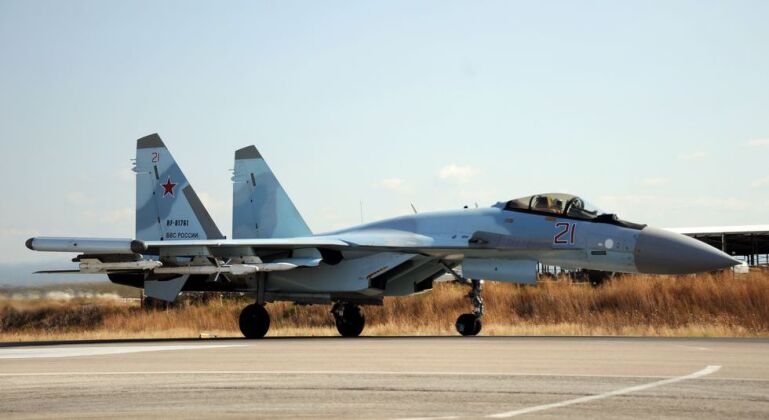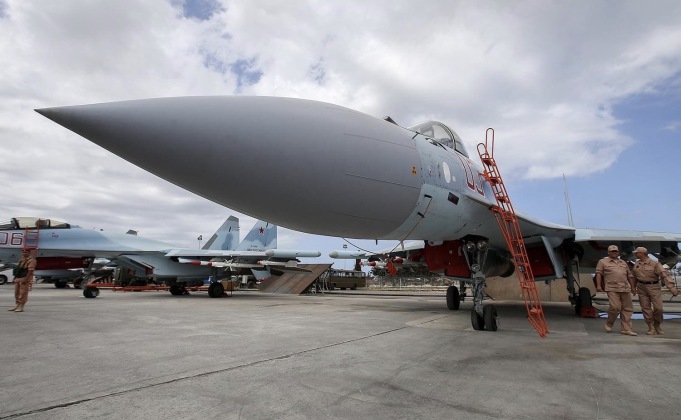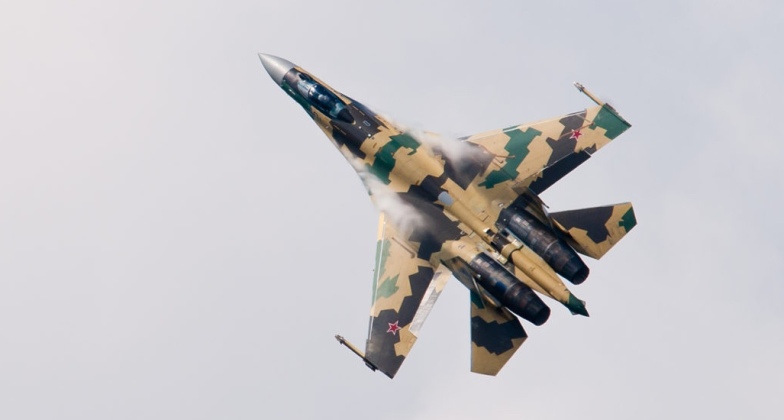News
Repelling Israeli and Turkish Attacks on Syria: How the Russian Su-35’s First Foreign Deployment Helped Save a Key Ally
Less than two years after it entered service in the Russian Air Force in February 2014 the new Su-35S ‘4++ generation’ heavyweight fighter made its first foreign deployment in January 2016 to reinforce Russian forces at Khmeimim Airbase in Eastern Syria. Constructed in August 2015 in preparation for a military intervention to support Syrian government counterinsurgency efforts the following month, combat aircraft deployed to the facility at the outset of operations including 12 Su-24M and 4 Su-34 strike fighters, 12 Su-25 attack jets, 4 Su-30SM multirole fighters and 12 Mi-24P attack helicopters. Although the intervention was intended to support counterinsurgency efforts, the threat of attacks by state supporters of the insurgency led to the deployment from November of assets optimised for air defence duties, namely Su-27SM3 air superiority fighters and S-400 long range surface to air missile systems. The Su-27s deployed to protect Russian forces were replaced by Su-35s from January the following year. Su-35s deployed to Syria were notably the first Russian fighters ever seen equipped with R-77-1 active radar guided air to air missiles, a weapons type which had become the norm in the United States, China and India in the 1990s, but which Russia had not financed for its own air force until the mid-2010s.

The threat of air attacks on Russian forces in the theatre was highlighted on November 24, 2015 by the Turkish Air Force’s deployment of F-16s to provide cover to Turkic jihadist militias on the ground and shoot down a Russian Su-24M – an aircraft which lacked even defensive air to air missiles. Turkey was seen to pose a particular threat to Russian forces, and of all NATO members seeking to overthrow the Syrian government was the most heavily invested in doing so. The attack was a key factor in the decision to deploy Su-27s and then Su-35s. When the first Su-35s arrived in Syria Russia faced tensions not only with Turkey, but with multiple NATO members which were seeking to create no fly zones on Syrian territory that would provide cover to insurgents from Syrian government air strikes. The deployment of Russian aircraft even in limited numbers at the invitation of Damascus ultimately ruled out such options, and meant Western and Turkish forces would need to engage the Russian Air Force directly if they intended to enforce a no fly zone over Syria. The deployment of Russia’s top air superiority fighters to the theatre served to help Russia draw a red line against such action.

The Su-35 would on multiple occasions be deployed to intercept Western, Turkish and Israeli aircraft over Syrian territory, with aircraft from the latter two states very frequently providing air support to insurgents by launching air strikes on Syrian government forces. As Syrian forces made advances in the country’s northwestern Idlib governate in the summer of 2019, leading Turkey to deploy F-16s on August 20 to cover the retreat of Turkish-backed Islamist militants, Su-35s were scrambled to intercept the aircraft and force them to leave Syrian airspace. This served as an important constraint on Turkey’s ability to use its air power to influence the course of hostilities as Syrian forces made significant gains on the ground. Turkey nevertheless intervened more forcefully, and on October 15 a Turkish F-16 fighter intercepted a Russian Su-35 within Syrian airspace and prevented it from launching a strike on an insurgent headquarters in Manbij. From January the following year Turkish F-16s and drone units provided air support to militant groups after they lost considerable ground near Idlib, and while Russian air strikes during the subsequent clashes caused dozens of Turkish military casualties, namely among ground units embedded within jihadist militia units, Russia’s willingness to provide a more comprehensive defence of northwestern Syrian airspace proved limited.

Alongside Turkey, a leading perpetrator of violations of Syrian airspace was the Israeli Air Force, with Su-35s and on some occasions even Su-34s deployed to intercept Israeli F-16s and prevent attacks. One such incident occurred just a week after the interception of Turkish F-16s, when August 26, 2019 two Su-35S intercepted Israeli fighters over the Mediterranean Sea which were preparing for attacks on Syrian targets, forcing them to retreat. On September 10, 2019, Su-35s intercepted several Israeli aircraft over the Southern Syria and prevented them from launching airstrikes. Nine days later a pair of Su-35s prevented Israeli aircraft from attacking the suburbs of the Syrian capital Damascus. On November 12 Su-35s again intercepted an Israeli fighter to prevent airstrikes on Damascus, and on December 7 several Israeli aircraft were intercepted by Su-35s and forced to retreat during an attempt to bomb the Syrian Air Force’s primarily operational facility Tiyas Air Base.

Su-35s were an important component of the Russian military intervention in Syria, and are expected to remain in the country indefinitely as the strategic importance of Khmeimim Airbase on NATO’s southern flank has only grown as tensions between Moscow and the Western alliance increase. The aircraft have increasingly exercised with local forces to help restore Syrian Air Force capabilities, and have also been involved in interceptions of American aircraft within Syrian airspace. This included multiple very close intercepts of American MQ-9 Reaper drones over Syria in the summer of 2023, one of which on July 23 caused the U.S. Air Force plane to take severe damage to its propeller after a Su-35 dropped flares in its path. U.S. forces, much like those of Turkey and Israel, have neither permission from the Syrian government nor authorisation from the United Nations Security Council to operate within Syrian territory, which has allowed Russia to justify supporting Syrian efforts to expel them from the country. With the Su-35 having been improved on based on experience operating over Syria, it has since 2022 become the most extensively combat tested of any post-Cold War fighter in terms of its air to air capabilities, and has seen dozens of engagements with Ukrainian air force aircraft in air to air combat providing a well burnished combat record. The Su-35 is nevertheless falling increasingly behind the latest Chinese and American fighter classes in many of its technologies, increasing the urgency for modernising the aircraft and equipping it with improved R-77M air to air missiles.












